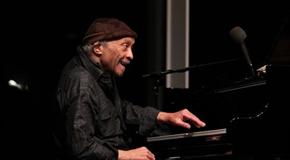Features
Pianist Cecil Taylor Makes Triumphant Comeback At Whitney
No one in the audience Thursday night knew quite what to expect from Taylor. This was only his fourth public performance in the past four years, the last a brief solo at the June 2015 funeral of Ornette Coleman, who along with Taylor revolutionized jazz by launching the free-jazz movement in the late ‘50s.
But though frail in body, Taylor was strong in spirit. Once his hands touched the keyboard, he again displayed his orchestral approach and commanding virtuosity, with percussive flurries, sudden changes in loud-soft dynamics and dancer-like leaps across the octaves.

After the performance, Jason Moran, a leading contemporary jazz pianist who was in the audience, said he was impressed with just how much ferocity, integrity, pacing and care Taylor showed.
“With Cecil, it’s like all of a sudden the years peel away,” said Moran, who considers Taylor one of his main influences. “That’s the elixir of the music. .. When musicians get really excited about an idea, it gives them that much energy.”
The performance opened an exhibition titled “Open Plan: Cecil Taylor,” running until April 24.
Taylor performed with two long-time collaborators, Britain’s Tony Oxley on electronics rather than his usual drum kit and Japanese modern dancer Min Tanaka.
The energy from Taylor’s piano flowed to Tanaka who moved around the room, shifting from graceful slow-motion movements to frenetic gestures in response to the music. As the music subsided, he waved his arms around Taylor before settling into repose.
It was an appropriate opening for an exhibition celebrating not only Taylor’s music, but also his deep connection to dance, poetry and other art forms.
“I want people to understand why this person who is truly a maverick is an utterly important 20th-century artist,” said the Whitney’s Jay Sanders, who co-curated the exhibit with Lawrence Kumpf, artistic director of the Brooklyn-based Issue Project Room. “We want to bring his past forward in the present.”
Though Taylor eschews revisiting his past, the exhibition includes audio and video listening stations, offering music dating back to his 1956 debut album “Jazz Advance.”
On display are album covers and concert posters, scores with his personalized notation system, and hand-written pages from journals of unpublished poems.
The scheduled events include performances by past Taylor collaborators and film screenings.
The curators hope the Whitney experience will encourage Taylor to perform. The pianist went through a rough patch when his one-time friend and contractor was sentenced to prison for stealing most of the $500,000 he received by winning the prestigious Kyoto Prize in 2013.
Taylor, who has a long association with the Whitney, has been coming to the museum’s new building several times a month to practice on a baby grand piano in the private trustee room.
It’s not known whether Taylor will play again during the exhibition, but he did give an unannounced performance Thursday night after the trio’s set with an octet he called The New Unit, including spoken word artist Jane Grenier Balgochian and saxophonists Harri Sjostrom, Elliott Levin and Bobby Zankel.
With a broad smile on his face, Taylor percussively slapped his hands on the piano as the music built to a cacophonous, free-form climax before settling down with Taylor standing up to incant his own verse. He closed a triumphant comeback with a quiet “Thank you” to the audience.